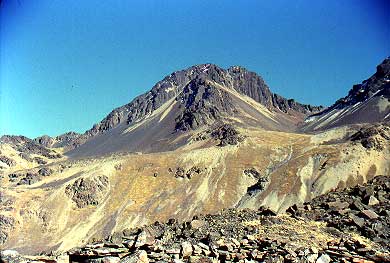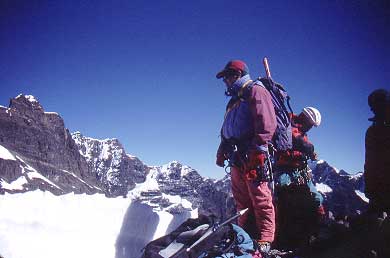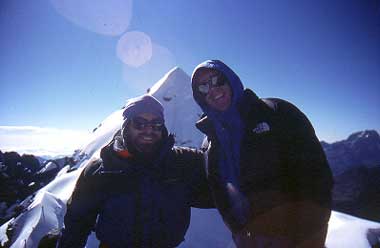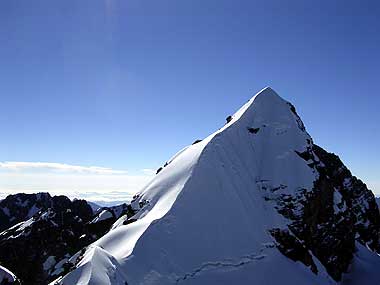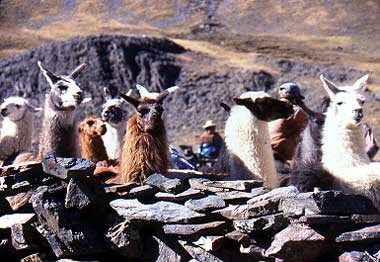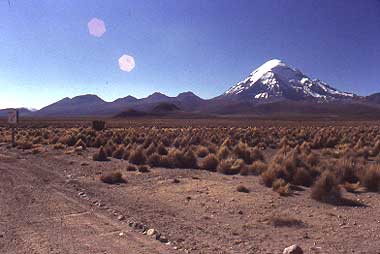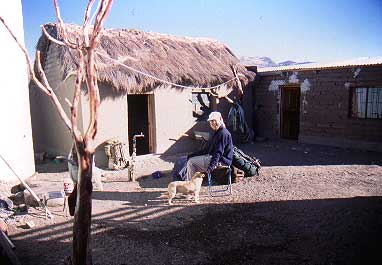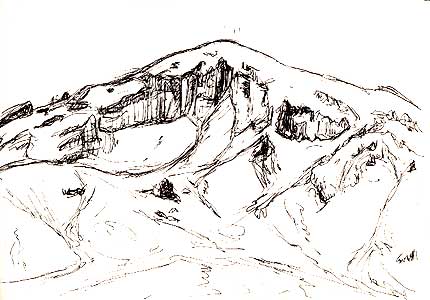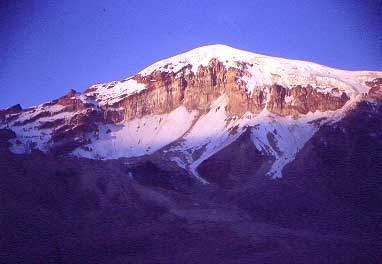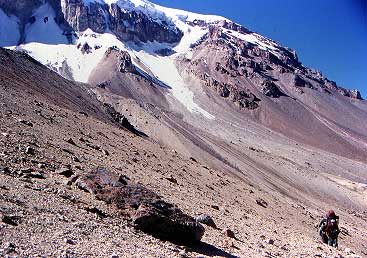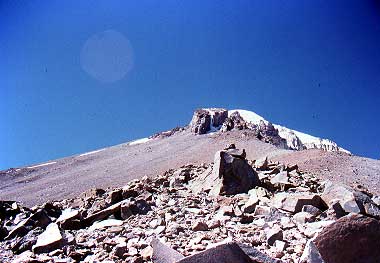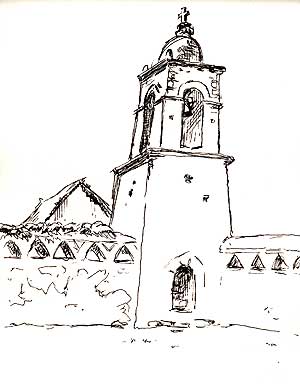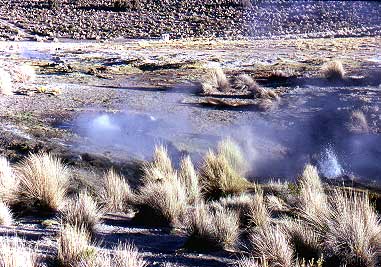An Expedition to Bolivia |
||||||||||||||||||||||||
Greg Frux, Joe McCoy, Matt Powell, Sr. Bernardo Guarachi, guide Our original objectives
included the ascent of Condoriri (18,530 ft) and Sajama (21,463 ft).
| ||||||||||||||||||||||||
Condoriri Base Camp, La Paz, BoliviaJune
18 Departed La Paz for Condoriri base camp. About a two hour
drive up and out of the city. First on paved roads across the altiplano
with the 20,000 foot peak of Huayna Potosi and the rest of the Cordillera
Real to our right. Usual wild traffic of buses, trucks, collectivos and vendors wandering across the two lanes. Somehow it all worked.
Then we turned up a dusty dirt road past little villages approaching the
mountains. Unload where the road ends, met by porters. They
pack everything onto mules and llamas. They have to hold the llamas
by the ears or put them in a head lock to load them. Then, an easy four mile
walk up to a lake surrounded by mountains. We are welcomed with our
tents already set up for us. Climbing teams from about six countries
here. Settle in at 15,000 foot elevation to sleep, very cold as soon
as sun goes behind mountains.
June 19.
Climb Cerro Austria with Patricia the first Bolivian woman guide. Route
is mostly a rough hike up meadows. Higher up we cross gravel and
boulder fields. It is steep and we feel the altitude, but make the
summit ridge in under three hours. Other side drops away pretty spectacularly...
we don't get too close. Summit is 17,090 ft. Return with ease
to base camp. Weather gradually gets worse in afternoon, with ominous
clouds around summits. Unusual for this time of year. Kind
of cold and raw, have to burrow into our tents.
June 20. Violent hail during the night. Snowing in the morning. Planned climb postponed one day. Not much to do but stay warm and read. Sun eventually comes out, rapidly evaporates three inches of snow. Very beautiful here... llamas grazing, climbers from U.S.A., Brazil, England, Hungary and Chile. Joe and I suffering minor head colds, which aren't slowing us down. June 21. Wake 4 am for climb. About an hour to the glacier, using alternately full moon and headlamp. Separate party (large) of Americans also guided by Andes Ex. on same route sharing resources. At glacier's edge Joe has to turn back because of gut troubles. Rope up, Pat, Matt and I. Make good time up glacier, climbing about 1500 feet in two and a half hours, as dawn rises. Cold wind at top. Climb 40 degree slope to rock summit Tarija (about 17,000 ft.). Too many people on a tiny summit (20 or more) including big incompetent Brazilian party. We had to wait here about an hour and Matt and I seriously thought about turning back. Fortunately Bernardo G. and Canadian guide organized things and went ahead to fix some ropes for climb to summit of Pequeno Alpamayo. Brazilians went up on separate line, out of our route (thank goodness). Matt and I were given priority as we had been waiting longest and were considered the most experienced. Pequeno looks like a giant shark fin, our route climbing up the edge. To climb it we had to descend about 150 feet of loose rock. Then across a knife edge snow ridge, Pat belaying us. Route then climbed about 800 feet of steep snow at about 40 to 55 degrees. This is where we used the fixed ropes with ascenders, Pat roped to us. Very hot work as the sun suddenly heated up. Summited at noon after seven hours of hard work. Carefully reversed the route. Reached camp at 4:30 pm, just managing to change clothes and climb into my sleeping bag. Did get up for dinner, however.

June 22
Decided not to try Condoriri, since it is considered harder than Pequena
A. and Joe isn't totally well yet. Grab handy llama caravan back to
road head and reach La Paz by 3 pm for much needed showers. Plan
to use additional days in West of country.
June 23 Awake in La Paz hotel. Afraid I have more energy than the rest of the gang put together. Spend a goodly portion of the day up in the crafts and witch's markets. Help buddies with gifts and charms. Have pizza for lunch at famous Israeli place, El Lobo (Wolfies). No way to describe this mad and delightful town. Cars, taxies, buses, collectivos careen everywhere. Cavalcades of vendors, businessmen, students, shoe shine boys in masks (ask them and they tell you it is 'Ben Lauden' fashion), beggars, police, military... Everyone from Aymara women to auto mechanics in some sort of uniform. We are exhilarated. Start a project of my own, in that I arrange for a translator and get a tour of the postal museum and meet one of the designers of Bolivian stamps. That is another tale, which I hope to write of elsewhere. Return to hotel to pack. Buddies are quite spent. Near fatal encounter with hotel dinner doesn't help. The chicken could best be described as unfortunate. |
||||||||||||||||||||||||
Sajama, BoliviaJune 24 Joe has not gotten over his gut bug. We all decide it wouldn't be smart or safe for him to continue on the trip. Hope to hook up later, but this is doubtful. This is very unhappy decision. Matt and I take off with Eduardo, Pat, a driver and porter Anastacio in big Toyota Landcruisers for parts remote around 10 am. The big surprise is that the highway across the desert into Chile and Arica has been radically improved. It is now the best road in Bolivia. This is to say that it is the equal of a two lane US highway. The route is very important to Bolivia, because it is the closest ocean going port. Fiesta San Juan last night and the smog from bon fires is awful at first. Latter the road passes all sorts of
marvels that remind us of the American west. Landscapes like Montana
and New Mexico, layers of eroded rocks, canyons, badlands. Stop at
some stone towers, an archeological site. These are chullpas, 500
year old tombs. Sure enough the bones are still inside!
Sajama soon towers over everything,
a great ice cap above huge cliffs, with several other 6000 meter volcanoes
nearby. We drive into the National Park, circling the mountain.
The village of Sajama is park headquarters and we are happy to see some
real park infrastructure. The town is our new base of operations.
About four blocks of adobe houses with wide streets that would film well
for a bad western, including the blowing dust. Also a large baroque
church, built out of stone and adobe, dating back to the Colonial period.
For a town of seventy souls it is very lively. There is an artisan´s
cooperative, several restaurants, numerous sweet and friendly children,
and a very entertaining dog population.
Situate ourselves in a refugio and feast on Eduardo´s scratch made veggie soup. Our new home has beds, windows, a door, a toilet (outside) flushed by a bucket of water and single light powered by a propane tank. It doesn't have heat, however. The nights at Sajama village, elevation 13,700 feet, last about fourteen hours and the bucket to flush the toilet freezes solid.
June 25 In theory a
rest and acclimatization day. Decide to visit nearby hot springs.
Car has mysteriously been recalled to La Paz. Not a problem, it isn't
far, according to Eduardo. Walk out there. Beautiful hot pools
welling up amid sparse vegetation, ice, salt and huge peaks. Soak
our brains out. Walk back seems to take forever! Later Matt
and I figure out that the round trip is ten miles (not far for Bolivians!).
Do little painting of twin 6000 meter volcanoes. Notice road running straight up to hill top. Ask Eduardo, it is, as I suspected, a ceremonial road where the villagers make offerings to "Doctor" Sajama. Prepare our gear for tomorrow's climb. June 26 Muleteers show up around 9 am. Most of our
loads go on the backs of two burros. We still carry food, water,
pile clothes and a down parka. Follow road out of town, circling the
mountain. A very pleasant trail winds up a valley through quenua
trees, which grow higher than any other tree on earth. They look a little
like creosote bushes with red trunks. There is even a little stream,
which is unusual and charming.
Make our way uphill from 13,700 feet to Sajama base camp at about 15,400 feet. As we climb up valley the massive cliffs of the volcano loom ever closer. There are vertical drops bigger than the Empire State Building on this face and the entire mountain towers more than a mile above us. Impressive as hell. Very cozy campsite, next to a spring, on a flat meadow. Noticeably colder here though.
June 27 Matt had a bad night and has decided not to go
on to high camp. He describes himself as out of gas. High altitude,
the work and cold are very draining. He goes back to Sajama village
with a porter. I continue on up with Eduardo, Anastastio, and another
porter. Here the route is such that pack animals cannot follow.
We hike up loose screeflanking up and left to avoid the cliffs. Circle
some way around the mountain and acquire a ridge. We are making for
a massive rock, above which sits high camp. I am aware we are climbing
rapidly, despite rests every hour. It only gets hard when we reach
the rock formation and have to scramble looser scree to one side of the rock until
we are above it. Only this last part leaves me really winded.
Shocked to reach high camp, around 18,200 feet in under four
hours.
Fierce setting, at which perch several level tent platforms, snow and
glacier above, rock and scree falling away at 45 to 60 degrees on two sides.
Eduardo is brilliant and gets a tent up fast and very well secured and
cooks up some food. We watch two German climbers, clearly exhausted, descend
to our level. They made the summit after an 8 hour climb and are
now headed to base camp.
Unfortunately I am soon feeling symptoms of acute mountain sickness. This isn't unusual and generally abates. I get a headache, and later some numbness in my hands and feet. Also, it is nearly impossible to sleep. Ed and I try coca tea and aspirin, but without success. The sickness gets no better. Very frustrating. An extremely cold and sleepless night follows. I make a judgment call that I am in no shape to climb 3000 feet of snow and ice to the summit. (I mean I could certainly attempt it if not for the high altitude sickness). Feel very comfortable in aborting the climb, it is the safe thing to do! June 28. That was a miserable night in my sleeping bag with all my clothes on, checking my watch every twenty minutes. With dawn comes gale force winds. Tell Eduardo I need to get down urgently. We break camp in the cold. E. and A. pack heroic loads, as we don't have a porter coming up today. Move well down the scree, sliding and balancing on ski poles. When we have descended 1000 feet, my symptoms have begun to fade. We arrive at base camp at 1130 am and I am feeling good enough to eat lunch. Several good hard marches put us back in Sajama village by 3 pm, a descent of 4500 feet in 6 hours. I am glad to see Matt, and am fully recovered, excepting for needing to catch up on sleep.
June 29. Rest in Sajama village. Do a second painting, this time of Sajama peak, with ceremonial line off to one side. Explore every drop of this tiny town, draw the church, buy a Coke, visit the crafts collective. Lunch with Matt by Rio Sajama, a stream really, but with sea gulls of all things. Plan to head back to La Paz tomorrow, but we are pretty restless by
mid afternoon. Fortunately we find a car and driver and with Eduardo´s
help drive out the geyser basin. (E. pointed out it was just an hours
walk each way... meaning ten mile round trip, but we insisted on a car!)
Got to see exciting geothermal actions, boiling pools, fumeroles, and geysers
just as sun was setting. Pretty thrilling wrap up to quiet day.
Got to take our guide and porter out to the best restaurant in Sajama. No expense was spared. Great traditional soup, followed by rice, baby alpaca meat, French fries and coca tea. (I had to try the alpaca... which tastes better than beef). Total cost for meal for four 31 Bs. That is less than four dollars. Car arrived late, to bring us back to La Paz in the morning.
June 30 Journey back to La Paz via a slow and long route. But fun. Stop at another hot springs in the park, soak an hour. Travel the old road (dirt) around Sajama. See herds of rare and endangered vicuna. Visit another Baroque church. Next to it is a new hotel, where, gasp, there will be heat, electric lights and hot water. I think that is pretty good for $25 per night. Really smart design too, traditional architecture, plus solar panels and other middle tech features. Get back on the paved road. One more stop at 17th Century Church, interior covered with murals painted by indigenous artists. It is unique. Arrived in La Paz 5:30 pm. Celebratory self cleaning followed. Revel in heat, light and yes TV.
Go out to folk music club Huari. Truly bazaar. Fine Andean
bands performed throughout dinner, for a hefty (for Bolivia)
July 2 Wake at 7, Eduardo met me at 8 am. Go to Zongo
Pass, elevation 15,200. Climb for three and a half hours to summit of
Back safe in La Paz. Hope to meet Bill and Mary B. for dinner. All is well. |
||||||||||||||||||||||||
About Gregory Frux |
Wilderness Painting |
New York City Paintings |
Etchings |
|
| All contents © 2017 Gregory Frux | ||||





